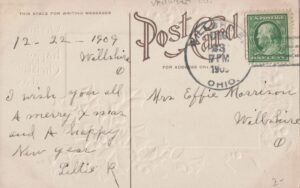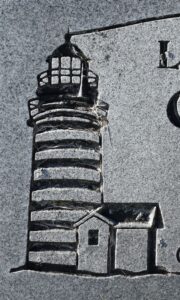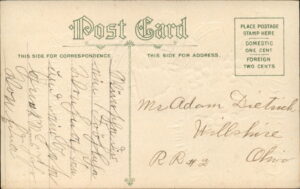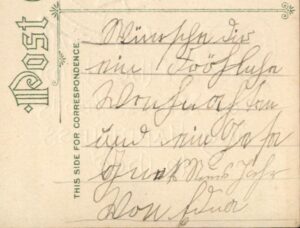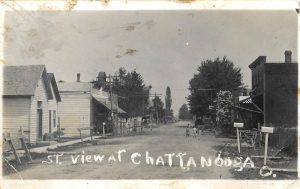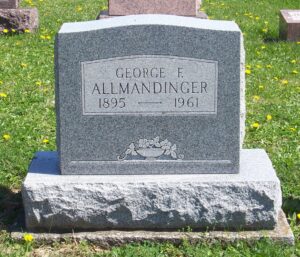
George F. Allmandinger, Zion Lutheran Cemetery, Van Wert County, Ohio. (2012 photo by Karen)
This is the tombstone of George Frederick Allmandinger, located in row 2 of Zion Lutheran Cemetery, Schumm, Van Wert County, Ohio. The marker is inscribed:
George F.
ALLMANDINGER
1895-1961
George Frederick Allmandinger was born in Mercer County, Ohio, 10 November 1895, the son of Frederick (1869-1953) and Anna Katharine (Kallenberger) (1875-1944) Allmandinger. George F. was baptized by P.S. Hunzicker at Zion Lutheran Church, Chattanooga, Ohio, on 28 November 1895. His parents served as his baptismal sponsors.
The Frederick Allmandinger household in 1900: Fred, 30; Anna, 24; George F, 4; and Paulena, 1. Frederick farmed. [1] They resided in the same place in 1910 and had three additional children by that time, Rudolf B, 7; Carl M, 4; and Elizabeth, 2. [2]
In 1911 the Frederick Allmandinger family moved to Liberty Township, Van Wert County. The family in 1920: Fred, 56; Anna, 46; George, 24; Paulena, 21; Rudolf, 16; Carl, 14; Elizabeth, 12; and Matilda, 9. [3]
In 1930 George F. Allmandinger, 34, and his sister Matilda, 29, lived at home with their parents Frederick and Anna. [4] By 1940 George, 44, was the only child living at home with his parents Frederick, 70, and Anna, 65. [5]
George’s mother Anna (Kallenberger) Allmandinger died 2 October 1944.
In 1950 George F. (54) resided with his sister Paulena (51) and her husband Herbert Merkle (50) in Pleasant Township, Van Wert County. George F. was unable to work because of a long-term disability. [6]
George’s father Frederick Allmandinger died 6 December 1953.
George Frederick Allmandinger died in Van Wert County 31 May 1961. He was buried next to his parents on 2 June.
George Allmandinger
Van Wert- George F. Allmandinger, 65, Liberty Township resident until a few months ago, died unexpectedly at 2:30 a.m. Wednesday in the home of his sister, Mrs. Herbert Merkle, in Pleasant Township. He had been ill much of his life.
He was born Nov. 10, 1895, in Black Creek Township in Mercer County to Frederick and Anna (Kallenberger) Allmandinger. He was never married.
He is survived by two brothers, Rudolf of Willshire Township and Karl of Celina Rt. 1; and three sisters, rs. Pauline Merkle, Mrs. Harold (Elizabeth) Giessler of Willshire Township ad Mrs. Herman (Matilda) Schaekel of ear Decatur.
Funeral services will be held at 1:15 p.m. Friday in the Zwick Funeral Home in Decatur and then at 2 p.m. in the Zion Lutheran Church in Schumm, of which he was a member. The Rev. Edward Zacharias will conduct the services. Burial will be in the church cemetery.
Friends may call in the funeral home. [7]
George had the following siblings:
Paulena Katharine (1898-1988), married Herbert D Merkle
Rudolf Benjamin (1903-1993), married Lula Anna Scare
Karl Michael (1905-1984), married Chloa Estella Smith
Elizabeth M (1907-1972), married Harold Alfred Giessler
Matilda Rebecca (1910-2009), married Herman William Schaekel
[1] 1900 U.S. Census, Black Creek, Mercer, Ohio, ED 74, p.8, dwelling & family 165, Fred Alma [sic]; Ancestry.com.
[2] 1910 U.S. Census, Black Creek, Mercer, Ohio, ED 107, p.5A, dwelling & family 99, Fredrick Allmandinger; Ancestry.com.
[3] 1920 U.S. Census, Liberty, Van Wert, Ohio, ED 127, p.2A, dwelling 5, family 6, Fred Allmandurgh [sic]; Ancestry.com.
[4] 1930 U.S. Census, Liberty, Van Wert, Ohio, ED 7, p.2B, dwelling & family 48, Fred Allmandinger; Ancestry.com.
[5] 1940 U.S. Census, Liberty, Van Wert, Ohio, ED 81-7, p.2B, household 37, Fred Almandinger [sic]; Ancestry.com.
[6] 1950 U.S. Census, Pleasant, Van Wert, Ohio, ED 81-25, sheet 776 [stamped], Herbert Merkle; Ancestry.com.
[7] George F. Allmandinger obituary, The Lima News, Lima, Ohio, 1 June 1961, p.2; Ancestry.com.

